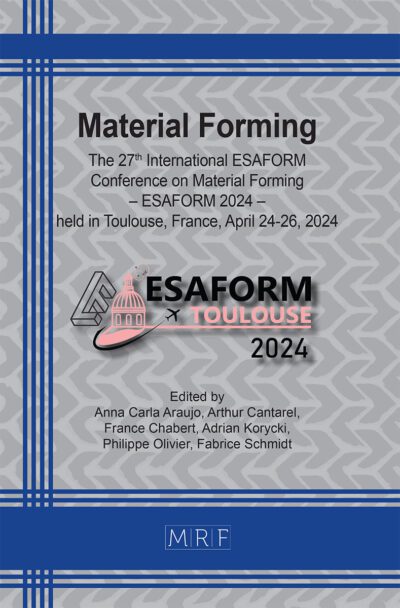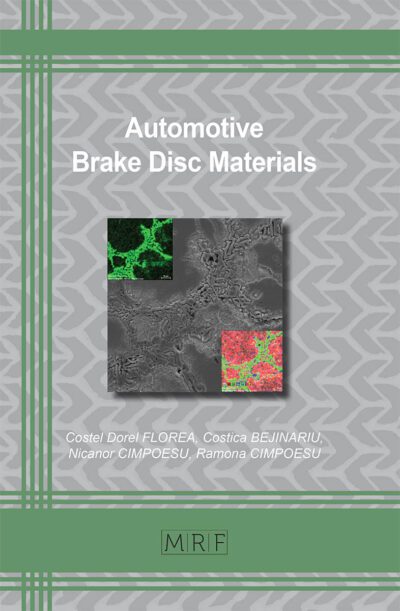Inhibition of tool surface degradation in hot forging through tailored forming of hybrid dies
Michael TILL, Julius PEDDINGHAUS, Janina SIRING, Johanna UHE, Kai BRUNOTTE
Abstract. In forging operations, a high service life of tools is crucial for maintaining efficiency and minimising operational costs. Tools in hot forging are subjected to a complex collective of extreme load mechanisms leading to wear and limited tool life. The primary cause for extensive wear in forging dies is the high temperatures in the surface zone, softening the die material and leading to plastic deformation and ultimately material removal [1]. To repress this mechanism and extend tool life, this work aims at enhancing the effected tool surface zone with a highly temperature-resistant nickel-based alloy. This approach is based on the superior heat resistance of nickel-based alloys and the robust mechanical properties of hot-work steels to significantly enhance tool service life in areas most susceptible to wear and thermal damage. To distribute the nickel-based alloy and achieve beneficial forming microstructure, a tailored forming process, developed in prior work is applied [2]. The focus of the presented work lies on the performance of the tailored formed forging dies depending on the applied nickel-based alloys and surface treatment. The tools are subjected to industry-related serial forging tests for a total of 2,000 cycles each. To analyse the potential for tool life extension in context of the current status quo in industrial forging processes, the results are compared with two reference tools of conventional tool steel with and without a nitrocarburized surface. After undergoing the forging process, the tool wear is measured optically before destructive testing with metallographic methods. The tool surface zones are characterised in terms of microstructure development and deterioration mechanisms and hardness changes as a result of the loads in the forging tests. The hybrid dies show a significantly lower tendency to wear compared to tools made from conventional hot-work tool steel. Based on these results, strategies for the application of this method in industrial forging process are deduced.
Keywords
Forging, Wear, Tailored Forming
Published online 5/7/2025, 10 pages
Copyright © 2025 by the author(s)
Published under license by Materials Research Forum LLC., Millersville PA, USA
Citation: Michael TILL, Julius PEDDINGHAUS, Janina SIRING, Johanna UHE, Kai BRUNOTTE, Inhibition of tool surface degradation in hot forging through tailored forming of hybrid dies, Materials Research Proceedings, Vol. 54, pp 849-858, 2025
DOI: https://doi.org/10.21741/9781644903599-91
The article was published as article 91 of the book Material Forming
![]() Content from this work may be used under the terms of the Creative Commons Attribution 3.0 license. Any further distribution of this work must maintain attribution to the author(s) and the title of the work, journal citation and DOI.
Content from this work may be used under the terms of the Creative Commons Attribution 3.0 license. Any further distribution of this work must maintain attribution to the author(s) and the title of the work, journal citation and DOI.
References
[1] Rajiev, R.; Sadagopan, P.; Shanmuga Prakash, R.: Study on investigation of hot forging die wear analysis – An industrial case study. In: Materials Today: Proceedings 27 (2020), S. 2752–2757. https://doi.org/10.1016/j.matpr.2019.11.330
[2] Siring, J.; Heine, C.; Till, M.; Wester, H.; Uhe, J.; Behrens, B.-A.; Brunotte K.; Numerical process design for the production of a hybrid die made of tool steel X38CrMoV5.3 and inconel 718, Materials Research Proceedings 41 (2024) 812-821. DOI: 10.21741/9781644903131-89
[3] Gronostajski, Z.; Kaszuba, M.; Polak, S.; Zwierzchowski, M.; Niechajowicz, A.; Hawryluk, M.: The failure mechanisms of hot forging dies. In: Materials Science and Engineering: A 657, S. 147–160 (2016). DOI: 10.1016/j.msea.2016.01.030.
[4] Emamverdian A., Smith P.; Current failure mechanisms and treatment methods of hot forging tools, Engineering Failure Analysis 45 (2021). https://doi.org/10.1016/j.engfailanal.2021.105678
[5] Barrau, O.; Boher, C.; Gras, R.; Rezai-Aria, F.: Analysis of the friction and wear behaviour of hot work tool steel for forging. In: Wear 255 (7-12), S. 1444–1454 (2003). DOI: 10.1016/S0043-1648(03)00280-1.
[6] Doege, E.; Behrens, B.-A.; Handbuch Umformtechnik – Grundlagen, Technologien, Maschinen. Springer-Verlag (2016). https://doi.org/10.1007/978-3-662-43891-6.
[7] Klobčar D., Tušek J., Flašker J.; Thermal fatigue cracking of die-casting dies, Engineering Failure Analysis 16 (2009) 785-792. https://doi.org/10.1016/j.engfailanal.2011.10.005
[8] Yilkiran, T.: Verschleißmechanismen oberflächen- und randschichtmodifizierter Gesenkschmiedewerkzeuge. Zugl.: Hannover, Univ., Diss., 2015. Garbsen: PZH-Verl. TEWISS – Technik und Wissen GmbH, 2015. ISBN: 978-3-95900-011-6
[9] Davis, J. R. (Hrsg.): Heat-resistant materials. 2. print. Materials Park, Ohio: ASM, (1999). ISBN: 0871705966
[10] Klocke, F.: Zerspanung mit geometrisch bestimmter Schneide. 9. Auflage. Berlin: Springer Vieweg, (2018). ISBN: 978-3662542064













